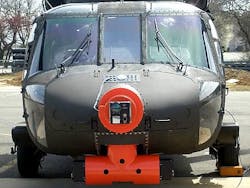Raytheon chooses Mercury for infrared sensor-processing subsystem for helicopter situational awareness
CHELMSFORD, Mass., 29 April 2012.Infrared sensors experts at the Raytheon Co. Space and Airborne Systems segment in El Segundo, Calif., needed an advanced sensor processing subsystem for the multi-function image processor in the Raytheon Advanced Distributed Aperture System (ADAS), which provides spherical situational awareness to helicopter crews. They found their solution from Mercury Computer Systems Inc. in Chelmsford, Mass.
Mercury (NASDAQ:MRCY) will provide an application-ready subsystem and integration services as part of Raytheon’s Multi-function Image Processor (MIP) on ADAS.
Mercury is providing a sensor processing subsystem that uses heterogeneous processing that includes field-programmable gate arrays (FPGAs) general-purpose graphics processing units GPGPUs, and graphics pipeline processors (GPPs) connected to high-speed switch fabrics.
The standards-based OpenVPX system is designed for future technology insertion for processing or handling sensors or modalities, Mercury officials say.
The ADAS works by mounting several high-resolution infrared sensors around the helicopter enable helicopter pilots and air crews to "look through" the airframe for 360-degree situational awareness.
Imagery from ADAS sensors links to helmet-mounted displays, and provides crew members with information customized to their separate roles. A 3D audio system issues threat alerts and crew communications from the direction of their source. The ADAS is to help improve safety at low altitude, in poor visibility, and in hostile environments.
ADAS makes key functions such as night vision, hostile fire indication, and infrared search and track interoperable with onboard countermeasures, and determines the intended target of inbound guided weapons and small arms fire to help helicopter pilots avoid these threats. ADAS also is suited to the demands of covert operations.
Future functions under consideration for integration with ADAS on manned or unmanned aircraft include radar, laser warning, terrain and obstacle databases, and advanced targeting, Raytheon officials say.
Raytheon is enhancing the Advanced Distributed Aperture System together with the U.S. Army's Research Development and Engineering Command; Communications-Electronics Research, Development and Engineering Center; and Night Vision and Electronic Sensors Directorate. Mercury's Services and Systems Integration team will do the technology integration.
For more information contact Mercury Computer Systems online at www.mc.com, or Raytheon Space and Airborne Systems at www.raytheon.com. More information on the ADAS is at www.raytheon.com/capabilities/products/adas.
Follow Military & Aerospace Electronics and Avionics Intelligence news updates on Twitter

